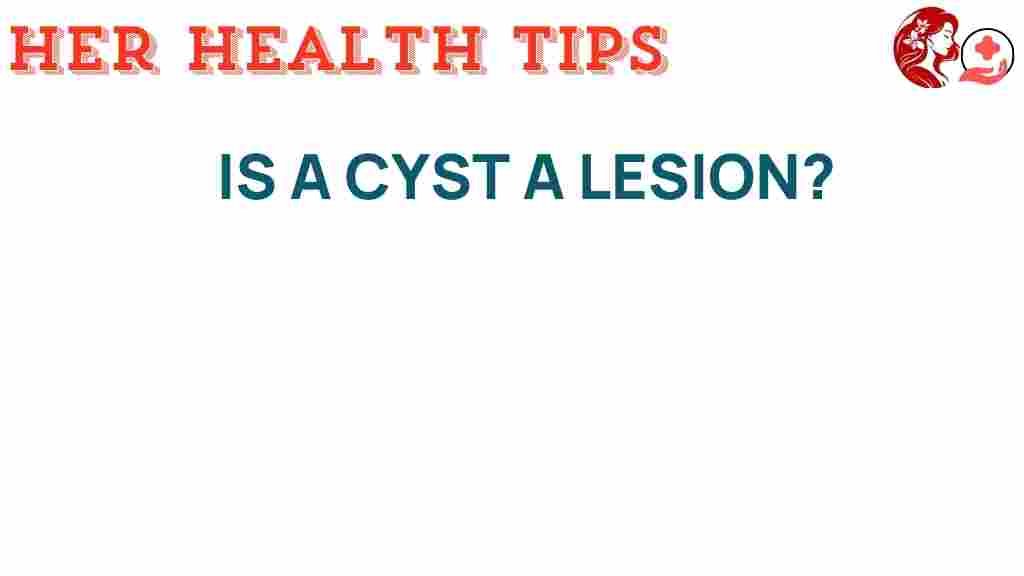Unpacking the Mystery: Is a Cyst a Lesion?
The world of medical terminology can often be confusing, especially when it comes to terms like cyst and lesion. Many people are uncertain whether a cyst is classified as a lesion, and understanding these terms is crucial for making informed decisions about your health. In this article, we will explore the definitions, differences, symptoms, diagnosis, and treatment options related to cysts and lesions.
Understanding Cysts and Lesions
To properly address the question, “Is a cyst a lesion?”, we first need to define both terms:
- Cyst: A cyst is a closed sac-like structure that can be filled with fluid, semi-solid material, or gas. Cysts can develop in various tissues and organs in the body and are typically benign.
- Lesion: A lesion is a general term that refers to any abnormal tissue change or injury, which can include a wide range of conditions such as tumors, ulcers, and cysts. Lesions can be benign or malignant.
From these definitions, we can see that while all cysts can be considered lesions due to their abnormal nature, not all lesions are cysts. This distinction is important for understanding medical diagnoses and treatment options.
The Differences Between Cysts and Lesions
Now that we have defined both terms, let’s delve deeper into the differences between cysts and lesions:
- Composition: Cysts are fluid-filled sacs, while lesions can be composed of various types of tissue, including solid, liquid, or even necrotic (dead) tissue.
- Causes: Cysts often arise from blockages in ducts, infections, or genetic conditions. Lesions, on the other hand, can occur due to a broader range of causes, including trauma, inflammation, infections, or cancer.
- Diagnosis: Diagnosing a cyst often involves imaging tests like ultrasound or MRI, while lesions may require a biopsy to determine their nature and whether they are benign or malignant.
- Treatment: Treatment for cysts might involve drainage or surgical removal, whereas lesions may require more extensive treatments based on their type, such as chemotherapy for malignant lesions.
Common Symptoms of Cysts and Lesions
Identifying whether you have a cyst or another type of lesion can be challenging, as symptoms can vary widely. Common symptoms include:
- Swelling: Both cysts and lesions may cause swelling in the affected area.
- Pain: Cysts can be painless, but if they become infected or larger, they can cause discomfort. Lesions may be painful depending on their location and type.
- Changes in skin or tissue: Some lesions may present as changes in the color or texture of the skin.
- Fever or systemic symptoms: If a cyst or lesion is infected, it may lead to fever or other systemic symptoms.
Diagnosing Cysts and Lesions
Diagnosis is a critical step in managing health concerns related to cysts and lesions. Here’s how healthcare providers typically approach diagnosis:
- Medical History: The doctor will review your medical history and any symptoms you have been experiencing.
- Physical Examination: A thorough physical exam may reveal the presence of lumps or abnormalities.
- Imaging Tests: Techniques such as ultrasound, CT scans, or MRIs can help visualize the cyst or lesion.
- Biopsy: If necessary, a biopsy may be performed to determine the nature of a lesion, especially if cancer is a concern.
For more information on diagnostic procedures, visit this link.
Treatment Options for Cysts and Lesions
The treatment for a cyst or lesion greatly depends on its type, location, and underlying cause. Here are some common treatment options:
Treatment for Cysts
- Observation: If a cyst is small and asymptomatic, your doctor may recommend monitoring it over time.
- Drainage: Fluid-filled cysts can often be drained to relieve symptoms.
- Surgery: Surgical removal is an option for larger or problematic cysts.
Treatment for Lesions
- Observation: Similar to cysts, some benign lesions may not require immediate treatment.
- Medications: Anti-inflammatory medications or antibiotics may be prescribed if inflammation or infection is present.
- Surgery: Malignant lesions may require surgical removal along with surrounding tissue.
- Chemotherapy or Radiation: These treatments may be necessary for cancerous lesions.
Step-by-Step Process to Manage Cysts and Lesions
If you suspect you have a cyst or lesion, here’s a step-by-step guide to managing your situation:
- Self-Assessment: Monitor for symptoms such as swelling, pain, or changes in the skin.
- Consult a Healthcare Provider: Schedule an appointment to discuss your symptoms.
- Undergo Necessary Tests: Follow your doctor’s recommendations for imaging or biopsies.
- Follow Treatment Plans: Adhere to the treatment options prescribed by your healthcare provider.
- Regular Follow-ups: Keep regular appointments to monitor the condition and adjust treatment as needed.
Troubleshooting Common Concerns
Here are some troubleshooting tips if you experience issues related to cysts or lesions:
- If you notice increased pain or swelling: Contact your doctor immediately, as this may indicate infection or other complications.
- If a cyst or lesion changes in size or appearance: Schedule an evaluation to ensure it is not a sign of a more serious condition.
- For cosmetic concerns: Discuss options for removal with your healthcare provider if the cyst or lesion is affecting your appearance.
Conclusion
In conclusion, understanding the relationship between a cyst and a lesion is vital for anyone dealing with abnormal growths or changes in their body. While all cysts can be categorized as lesions, not all lesions are cysts. Recognizing the symptoms, seeking appropriate diagnosis, and following suitable treatment plans are essential steps in managing these conditions effectively. If you have concerns about a cyst or lesion, don’t hesitate to reach out to a healthcare professional for guidance.
For more information about health-related topics, check out this resource.
This article is in the category Conditions and created by HerHealthTips Team
